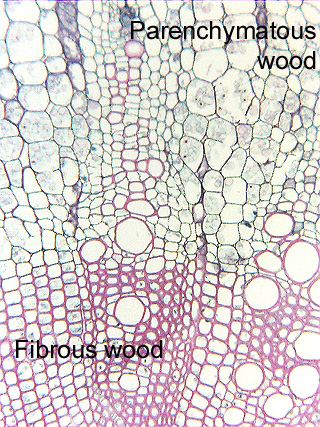 Fig.
15.4-1. Transverse section of dimorphic
wood in a climbing cactus (Werckleocereus glaber; no common
name). When the shoot was young and the vascular cambium was closer to the pith,
it produced the fibrous wood at the bottom of the micrograph. But when the shoot
became older, it began to produce a different type of wood, the parenchymatous
wood in the top part of the micrograph. Werckleocereus glaber clambers
through trees and brush, and when its slender stems fall onto a neighboring tree
limb, the cactus no longer has to hold itself up: it can rely on the tree for
that. At this point, it can produce a wood that no longer has the function of
support.
Fig.
15.4-1. Transverse section of dimorphic
wood in a climbing cactus (Werckleocereus glaber; no common
name). When the shoot was young and the vascular cambium was closer to the pith,
it produced the fibrous wood at the bottom of the micrograph. But when the shoot
became older, it began to produce a different type of wood, the parenchymatous
wood in the top part of the micrograph. Werckleocereus glaber clambers
through trees and brush, and when its slender stems fall onto a neighboring tree
limb, the cactus no longer has to hold itself up: it can rely on the tree for
that. At this point, it can produce a wood that no longer has the function of
support.
Dimorphic wood is known just from
cacti and had not been discovered when Plant Anatomy (Mauseth) was
written, but by now many types are known, and it is widespread in the family. For
more information, see the following papers:
1.
Mauseth, J. D., and B. J. Plemons. 1995. Developmentally variable, polymorphic
woods in cacti. American Journal of Botany 82: 1199 -- 1205.
2. Mauseth, J. D., and B. J.
Plemons-Rodriguez. 1997. Presence of paratracheal water storage tissue does not
alter vessel characters in cactus wood. American Journal of Botany 84:
815 -- 822.
3. Mauseth, J. D., and B. J. Plemons-Rodriguez. 1998. Evolution of extreme xeromorphic characters in wood: A study of nine evolutionary lines in Cactaceae. American Journal of Botany 85: 209 -- 218.